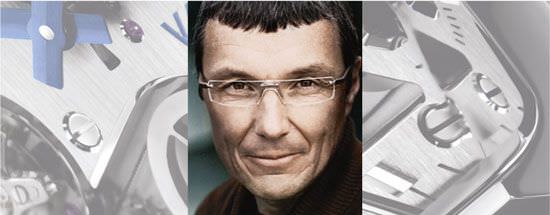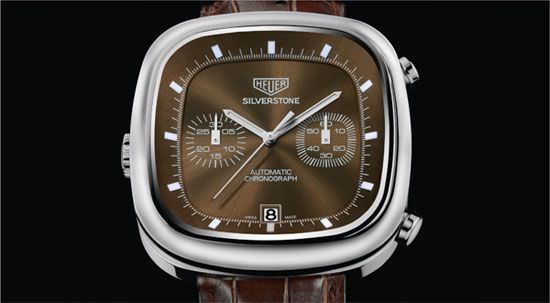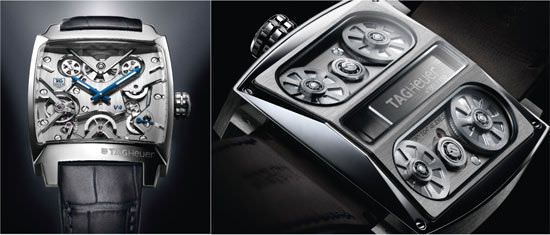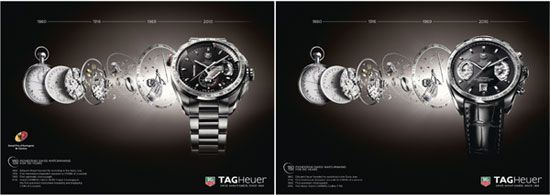Like all watch companies, TAG Heuer has had to confront the economic crisis. The brand’s sales have apparently taken a serious hit in the United States, its largest market, and they are lagging in China, where TAG Heuer has made major investments. To learn more, Europa Star talked with Jean-Christophe Babin. Without wavering on the issues—yet still not revealing precise numbers, LVMH group oblige—Babin answered our questions openly and clearly. He responded with a sort of ‘calm strength’, rational and well thought out, endeavouring to methodically describe the specific heritage of the brand in terms of technology, sportiness and innovation.

Jean-Christophe Babin
Europa Star: How has TAG Heuer confronted the crisis?
Jean-Christophe Babin: TAG Heuer is one of the few brands that has never succumbed to the explosion in prices or styles that preceded the crisis. We have always been extremely attentive to the price/quality ratio of our products. We were never tempted by the bling-bling fad but have consistently remained true to the precise limits of the brand, while developing it within our most legitimate boundaries.
If we have been—and still are—avant-garde, it is in the domain of technology, as our history shows, and not in the realm of stylistic expression. All the elements composing our identity have demonstrated their relevance in times of crises and have thus allowed us to get through this difficult period without having to readjust our offer to a lower level.
To say that we have not suffered would not be truthful, but we have succeeded in absorbing the shocks. Today, while money has become tight, the rationality of our offer and the strength of our brand—combined with an effective communication that fully maintains our ‘lifestyle’ identity—have become major assets and clear advantages for us in relation to the competition.
ES: In terms of products, has the current situation led you to transform your offer?
JCB: Our average price is around 3,000 Swiss francs. This is a price segment that applies to consumers for whom the purchase of a watch is a major act. The product they acquire must last, both technically and stylistically. We must respect this choice and thus not abruptly change, which would destabilize this choice by making the previous models obsolete. Changes must be done gradually.
The icons that are in our collections are chronological beacons. This permanence gives the brand its strength, especially today when the consumer is confused by an overabundance of contradictory offers and messages. In this context, the continuity of a brand plays a fundamental role. Presented and conducted with consistency and relevance, it helps the consumer to get his bearings.
TAG Heuer has a clear and prominent image. We are not shifting from this space but we will make it even deeper. For example, after the revitalization of our Carrera and Monaco icons, we are today presenting a new vintage Silverstone chronograph. Identical to the 1974 original, but equipped with a sapphire glass and caseback, it is a faithful reproduction that has been technically created using the parameters of the 21st century.

The NEW VINTAGE SILVERSTONE CHRONOGRAPH
Another example strengthens our image as an avant-garde innovator. After five years of development, we are introducing the Monaco V4. It is our Grande Complication but we are not going to add a grand sonnerie or a tourbillon. We are doing something better. We are deeply transforming watchmaking by inserting, for the first time, a belt drive, as well as a product that is resistant to shocks—5000 G. What other complicated watches can claim to be as resistant to temperature variations and as resilient as a TAG Heuer?

The MONACO V4
ES: How has the crisis affected your distribution?
JCB: I believe that it is not by chance that a study conducted with retailers by Goldman Sachs, following the last SIHH and BaselWorld shows, names TAG Heuer as Number One in terms of having “the most relevant new commercial products”. I stress the word “commercial”, since we have always been extremely attentive to offering our retailers products that are saleable.
This attitude has also helped us to resist the crisis and in the USA, for example, to regain in market share what we have lost in sales. Faced with a decrease in sales—a decrease that we have been able to control thanks to the strength of our brand image—we have helped retailers by switching our advertising to local newspapers and by increasing co-op ads with them.
Since the crisis crystallized the strong and weak points of our various products, we have taken back some products that have been repacked and sold through our American network of factory outlets. The use of these outlets, rather innovative in the watch world, lets us control our prices and our image. And, this channel was created precisely because our products are icons that evolve and are thus desirable to consumers who are looking obviously for quality and image but not necess-arily for the latest new model.
ES: And China?
JCB: In the Chinese market, where we have a wholly-owned subsidiary, we have mixed distribution with 90 multi-brand points of sale and seven of our own stores. In the same-name stores, we also sell our eyewear, access-ories and Meridiist telephones, which contribute greatly to our turnover and help to pay for the boutiques, which is always and everywhere a delicate issue.
But China has also taught us several lessons that are valid for the rest of the world. Our experience in this market has made us increase our mechanical offer, to improve our merchandizing and even to innovate in terms of advertising, with notably our new ‘Evolution’ campaign that more strongly emphasizes our legitimacy and our watchmaking history. Created for the Chinese market, this campaign will be rolled out internationally.

The new ‘Evolution’ campaign
ES: We know your dynamism on the Internet. What lessons have you learned in this domain?
JCB: The crisis has made us energize our efforts in terms of innovation and our presence on the Internet and social networking. At BaselWorld 2010, we will present an even more revolutionary initiative regarding the Internet. It will give us a three-year advance over the competition, even though we are already highly developed in this domain. Our prowess online is underscored by the fact that we were awarded first place among watch brands for the excellence of our Internet strategy, according to a study called ‘Digital IQ Index: Ranking the Digital Competence of Luxury Brands’, conducted by Luxury Lab of New York University’s Stern School of Business.
But beyond certain strong ‘viral’ marketing efforts, as for example the famous video called ‘The Duel’ that brought together Steve McQueen and Lewis Hamilton and that testifies to our absolute continuity and legit-imacy in the domain of the automobile, we are conducting other operations directly intended to facilitate the life of our consumers and our retailers.
In the USA, we are proposing to retailers, who have a website, what we call @telling. It is a veritable digital template that allows them to present our brand in its own visual environment. In the United States, we have also launched @sav, a digital after-sales service that allows the client to obtain a repair estimate online. Once he approves the estimate, he can follow the repair, step-by-step and can pay for the repair and shipping electronically.
In six months, 40 per cent of our after-sales service has moved to this model. With @commerce, we are selling our accessories, leather goods and bracelets—including about 40 TAG Heuer branded products—online. Yet, we don’t have the intention of directly selling our watches online since we prefer to work with our excellent retail network.
Source: Europa Star December-January 2010 Magazine Issue




